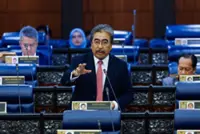Nik Zainal Abidin's artwork 'Wayang Kulit' (watercolour, 1969) is one of the many paintings from Bank Negara Malaysia Museum and Art Gallery's collection being exhibited at the 'Gerak Bayang: The Art Of Storytelling' show. Photo: Bank Negara Malaysia Collection
Before the advent of modern cinema and television, Malaysians – especially those living on the East Coast – had long been accustomed to the art of wayang kulit, (shadow puppets) in their villages.
The traditional art form – the most distinctive style of wayang kulit being the wayang kulit Siam, practised in Kelantan – remains one of the most celebrated national treasures.
Already a subscriber? Log in
Save 30% OFF The Star Digital Access
Cancel anytime. Ad-free. Unlimited access with perks.





